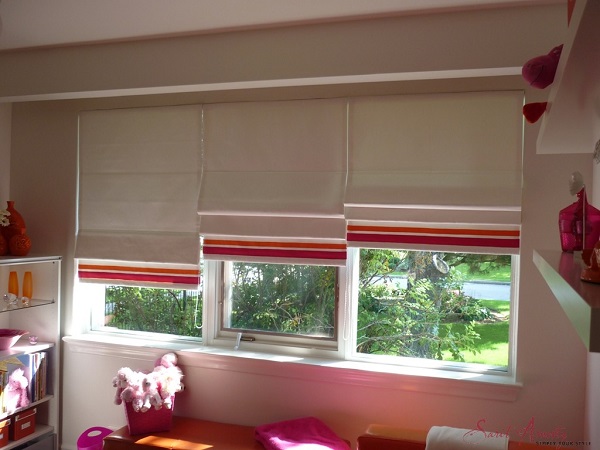
Roman shades provide a compelling alternative to custom drapes or remote control blinds that combines the best attributes of the two. They enable you to add some of the colour, texture and patterning effects you’d get with drapery but pull up and out of the way like blinds do. Choosing the Roman shades that are right for your Toronto home, however, will take a bit of time and thought because there are a number of popular fold styles to choose from. It’s an embarrassment of riches and that’s fine with us because, no matter how they fold, Roman shades endow a room with style and a timeless grace.
The Many Faces of the Roman Shade
The Roman shade is one of the interior decorator’s secret weapons because they’re both unexpected and yet right for so many types of settings and interior decoration schemes. Still, a fold style that is right for one home won’t necessarily be right for another and you will have to choose one. So below we’ll profile the main roman shade fold styles for you.
● Plain – The plain fold is produced using one long continuous piece of fabric so there are no seams when the shade is fully extended. The plain fold (also called the “flat” fold) offers a sleek profile that’s great for the living room where the shades are opened and closed with regularity. Plain folds have their fans and detractors with the former extolling their clean, sophisticated look and the latter taking issue with the single large, flat expanse of fabric when the shade is closed.
● Hobbled – Hobbled or soft Roman shades have a frumpy character a lot of people find appealing. The soft folds never really flatten out completely, even when the shades are extended all the way down and the effect is relaxed and lived in without looking worn out or “used”. The hobbled shade is most often used on large windows where it provides the expanse with some character.
● European – The European fold is perhaps the ultimate in relaxed window treatments. The bottom of the shade assumes a curve as the shade is raised and the folds are very gentle and discrete. You’ll have to train the European fold by leaving it open for a few days so that the pleats can form. The European fold is often found in a formal setting where the gentle bottom cure and soft folding provides the feel of expensive drapery.
● Batten front – The batten front shade features, as the name implies, battens that are sewn into the front of the shade at regular intervals. Batten front shade are often used with striped fabrics and the whole shade has an airy, seaside vibe to it that is both comfortable and practical. Use them for doors and shallow windows.
● Batten back – With the batten back design, the battens are integrated into the back of the shade which provides the front with a nice soft look. By moving the structural elements to the back of the shade this design opens up the front to a wider variety of patterns, textures, and designs. Still, it’s probably best if those designs and patterns are fairly muted or you may have a bit of visual dissonance when the shades are partially closed and backlit.
The Roman shade has survived centuries of changing tastes because they’re so versatile, practical, effective and easy to maintain. When compared to custom drapes or some other types of window treatments they’re also affordable and easy to install. Talk to the design professionals at Sarit Arnesty today to learn more about installing Roman shades in your Toronto home.
Disclosure: Collaborative Post
Photo Credit: Sarit Arnesty

